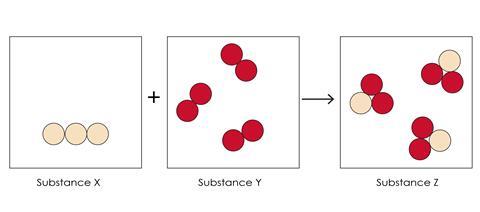Support learners to describe and evaluate the use of particle diagrams
This resource is part of our support for literacy in science teaching, designed to embed literacy into your curriculum and develop learners’ skills in reading, writing and talking about science and their understanding of scientific language.
-

Download this
Download the structure strips, which are printed five to a page, to support learners to find or retrieve information and write independently.
Find model answers in the teacher guidance.
View and download more Structure strips
Learning objectives
- Recall, draw and describe the particle model for solids, liquids and gases where particles are represented by circles/spheres.
- Use particle diagrams to represent chemical reactions and physical changes.
- Evaluate the use of particle diagrams.
Introduction
Particle diagrams are often used to show the arrangement of atoms and molecules in substances. It is important that we understand all the information given in these diagrams and their limitations.
How to use structure strips
Structure strips are a type of scaffolding you can use to support learners to retrieve information independently. Use them to take an overview at the start of the topic, to activate prior knowledge, or to summarise learning at the end of a teaching topic. For more ideas on how to use structure strips with your learners, see 5 ways to use structure strips effectively
Structure strips have sections containing prompts which are sized to suggest the amount that learners must write. Learners glue the strips into the margin of an exercise book and write their answers next to the sections, in full sentences. When learners have finished using the structure strip, they should have an A4 page set of notes and examples.
The strips are printed five to a page and will need to be trimmed to size. Find them on the second page of the student sheet.
Scaffolding
Additional scaffolding may be required to support learners to answer the questions. These could include a list of key words or additional prompts in the structure strip.
As learners grow in confidence, they may be able to attempt the follow-up question first and then use the structure strip to improve or self-assess their answer.
Keywords
solid, liquid, gas, substance, particle, atom, molecule, mixture, regular, irregular, arrangement.
Metacognition
This activity supports learners to develop their metacognitive skills in the three key areas:
- Planning: the strips provide scaffolding to plan the written response. Learners will decide where to gather information from (eg textbooks, own notes, revision websites). Ask learners: is the source of information I am using reliable?
- Monitoring: learners are prompted by the questions in the structure strip and can check their answer against the prompts. Ask learners: have you covered all of the questions in the space provided? Do you need to change anything to complete the task?
- Evaluation: learners can self-assess or ask a peer to check their work against the answers. Ask learners: did you achieve what you meant to achieve? What might you do differently next time?
Follow-up question
Learners should answer the question after they have attempted the structure strip. The structure strip activates the required knowledge which learners can then apply to the question.
The diagram shows a chemical reaction. Explain how the diagram shows this is a chemical reaction and what the diagram shows about the types and states of the substances involved. Suggest a symbol equation with state symbols that would fit the diagram.

Answers
Suggested answers for the structure strip activity are given in the downloadable teacher notes (MS Word | PDF).
Answer to follow-up question
The diagram shows a chemical reaction because the circles in the boxes show individual atoms. As the equation goes from reactants to products, the atoms in the reactants get rearranged and joined differently to make the products.
The diagram shows the atoms of substance X as a solid element. This is shown by the atoms touching each other in a regular arrangement and they are all the same colour, indicating they are the same type of atom.
The diagram shows substance Y is also an element which exists as (diatomic) molecules. The molecules are shown far away from each other, so substance Y is a gas.
Substance Z is a compound. This is shown by the different colour circles which are joined, indicating they are bonded. This substance is also a gas.
Possible equations:
- C(s) + O2(g) →CO2(g)
- S(s) + O2(g) → SO2(g)
Learners may suggest other similar equations.
Downloads
Particle diagrams structure strip student sheet
Handout | PDF, Size 0.31 mbParticle diagrams structure strip teacher notes and answers
Handout | PDF, Size 0.45 mbParticle diagrams structure strip student sheet
Editable handout | Word, Size 0.49 mbParticle diagrams structure strip teacher notes and answers
Editable handout | Word, Size 0.57 mb
































3 readers' comments